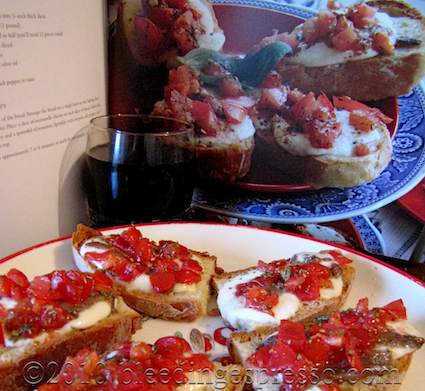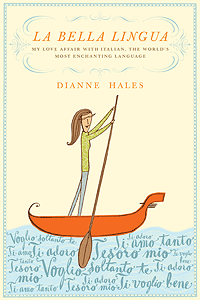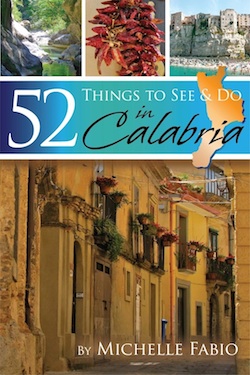Archive for the ‘books’ Category
Excerpt from BAROLO by Matthew Gavin Frank
 For all you Italy, wine, and book lovers out there, I’m pleased to present an excerpt from Matthew Gavin Frank‘s new book BAROLO, a memoir about Frank’s illegal work in the Piemontese Italian food and wine industry.
For all you Italy, wine, and book lovers out there, I’m pleased to present an excerpt from Matthew Gavin Frank‘s new book BAROLO, a memoir about Frank’s illegal work in the Piemontese Italian food and wine industry.
I’ve been hankering to get myself to Piemonte ever since “meeting” Diana of Creative Structures and the Baur B&B, and Frank’s book may be just what I need to hold myself over until I can get there.
The following piece originally appears, in slightly different form, in the food-and-wine memoir, BAROLO (The University of Nebraska Press, 2010), by Matthew Gavin Frank.
Coming to Temperature
I run my hand over my hair, spitting rain as cracked carbonation, and make for the indoors. The indoors takes the form of Alba, Italy’s Caffé Calissano, its cream awnings and shrub-lined exterior nearly kissing the orange stones of the Duomo.
Soon, I am drying off at a mother-of-pearl cafe table, my snifter of rosolio reflecting its oval pinkness in the white-tiled ceiling, as if assuring itself of its own existence before I pour it down my throat. This liqueur, which I’ve found only in Italy’s Piedmont, wears its rose-oil roots proudly in both smell and taste.
I sip and, petal-tongued, watch two raindrops race down Calissano’s window. I bet on the one on the right. It has a fatter bottom. It wins. Behind the window-rain, a helmetless boy passes on a rickety moped, disappears around the Duomo’s hip. Then, an elderly woman in a red plastic kerchief limps past grasping an armful of rolled bathmats to her chest.
If Alba is a body, I can’t tell if I’m the artificial heart or a virus. It exists around me, with me, despite me. It includes a young waitress, twentysomething, curly brown hair, green butterfly barrettes, who sets a small white plate of meat and mushrooms in front of me. She has a full face and short fingers. I didn’t order this.
“You are American, yes?” she says in a voice steeped as if in rosolio.
“I wear it like an overcoat, huh?”
“Aah,” she says, dismissing my ridiculousness, this is salami with the, uh, truffle, and the porcini in the, uh, vinegar.”
“Truffled salami?” I say on an inhale, my words sputtering as if spoken through a floor fan on high.
“Yes, this here,” she says, the face of her left pointer hovering dove-wise over the plate.
“And these…” I say, sniffing the dome smell of delicacy eight inches above the table, “Pickled porcinis?”
“Yes. Uh, you can not have a drink and, uh, not have something to eat. This is a rule.”
“Really? Just here, or in all of Italy?”
“Oh, everywhere.”
“Well, these are the best bar snacks I’ve ever seen,” I say, “This is a good law.”
She laughs, I think, because she feels she should.
“Mille grazie,” I say.
“Prego,” she says and returns to the masses.
Northern Italy is a region of wine and chandeliers and I sit as if in a crib, beneath yet another dangling mobile of crystal, shedding a gauzy orange light. I imagine that Piemontese writers Beppe Fenoglio and Cesare Pavese often sat beneath Calissano’s chandeliers with other local artists, eating, drinking, forging World War II’s partisan movement before playing bocce ball in the piazza.
Now, the Cinzano mirrors reflect the mostly businesses-suited patrons and waitstaff, clad in tuxedo shirts, loose bowties, black pants and black aprons.
The bar, stretching the length of the north wall, is patrolled by a young blond man, forever pacing its expanse, playing guard to the thousands of light-spitting bottles, filled with elixirs of red, white, clear, green, rose, yellow. The ceiling’s thick white tile is carved with oak leaves and wine grapes, fish flanks, and the occasional seraph. Calissano indeed seems a museum-turned-cafe and the staff roves among its tables so cleanly as if curators, no, sculptures come to life. Their hands and feet trace the nooks and bottles of their region.
I know, mouth now greased with truffle salami, cheeks now aglow with a post-porcini sting, that this is going to be my place in Alba. For the first time since arriving in Italy nearly a month ago, I’m infected with a sense of home. Uncommonly warm, I raise my snifter to an especially chubby ceiling angel, swear I see it wink, and swallow the thick last. At the bar, the young blond man rolls a raw porcini mushroom to the center of a wooden cutting board and hacks it in half with a meat cleaver. Even split, its stem is as thick as an arm.
Interested in more? Check out BAROLO for yourself!
Best Crostini Recipe Ever + Breaking Bread in L’Aquila
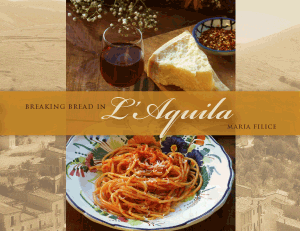 Maria Filice‘s Breaking Bread in L’Aquila is a product of love — love for her late husband Paul Piccone, of his native city L’Aquila in Abruzzo (yes, the same one that was devastated by an earthquake last year), of her own Calabrian heritage (Marie’s parents were born in Cosenza), and of delicious, simply prepared Italian food.
Maria Filice‘s Breaking Bread in L’Aquila is a product of love — love for her late husband Paul Piccone, of his native city L’Aquila in Abruzzo (yes, the same one that was devastated by an earthquake last year), of her own Calabrian heritage (Marie’s parents were born in Cosenza), and of delicious, simply prepared Italian food.
Marie graciously shares this amore with us, and indeed, is donating net proceeds of the book to the continuing relief efforts in Abruzzo and is also appearing in Santo Stefano di Sessanio, Abruzzo this Saturday, May 15, if you’re in the neighborhood!
The layout of this hardcover book is gorgeous with the recipes on the left side and full-color photos on the right — for each and every recipe. And the organization is unique as well: recipes are divided into menus that include antipasti (appetizers), primi piatti (usually pasta), secondi piatti (meat), contorni (vegetables), and dolci (desserts) for each day of the week; if you have a special dinner coming up, you can just open up Maria’s book and have a menu all set. Perfetto!
Many of Maria’s 50 or so recipes are classics like aglio olio peperoncino and bruschetta, but there are also some that were new to both Paolo and me. On my first run through, I made a note of at least five different recipes to try immediately with things we already had in the house.
In case you don’t realize, that’s pretty darn impressive for a southern Italian cookbook in a southern Italian house.
Speaking of items we had on hand, Maria also includes the “Pantry Page” with a checklist of things you should always keep handy. That stocked pantry is one of the most important parts of true Italian cooking, i.e., deciding what’s for dinner based on what you have on hand, and even better, having it on the table within about an hour. *That* is an Italian art form, and Maria has captured its essence wonderfully.
Breaking Bread in L’Aquila would be an excellent addition to any cookbook collection as it is not only full of great recipes, it’s simply a gorgeous book. Even if you don’t cook, you’ll enjoy the photos! And if you need a gift, particularly for someone with an interest in Italian and/or southern Italian cuisine, this is perfect.
I give this cookbook five extremely full espresso cups out of five; I couldn’t recommend it more.
**THIS CONTEST IS OVER**
Maria is offering up a copy of Breaking Bread in L’Aquila to one lucky Bleeding Espresso reader. Just comment on this post by May 20, 2010 at 11:59 p.m. (CET) to enter.
Now, without further ado, Maria’s recipe for Crostini with my slight adaptations; I am not exaggerating when I say I’ve made these at least once a week since I received Maria’s book (on Paolo’s specific request). We’ve had them as afternoon snacks and as dinner. They are so, so, so good — especially with a nice glass of red wine.
Crostini from Breaking Bread in L’Aquila by Maria Filice
(as adapted by me)
(serves 2)
- 6 slices of Italian bread, about 1/4 inch thick
- 2 small to medium-sized balls of fresh mozzarella, sliced
- 6 anchovy fillets
- 2 medium tomatoes, diced
- Handful of capers
- 1 tablespoon olive oil
- Oregano and salt to taste
1. Preheat oven to 375°F (190°C).
2. In a small bowl, mix together tomatoes, olive oil, oregano, and salt. Let stand while you arrange the rest.
3. Arrange slices of bread in a single layer on a baking sheet.
4. Place a slice or two of mozzarella on the bread so that you cover most of it.
5. Put an anchovy fillet on each slice of bread (more if you like anchovies like we do!).
6. Add some capers to each slice (I put three or four on each slice — we like capers too).
7. Cover the slices with the tomato mixture. I’ve found a fork actually works better than a spoon for this; you don’t want a whole lot of liquid making it onto the crostini as it’ll make the bread soggy.
8. Sprinkle with more oregano.
9. Bake in the oven for about 7 or 8 minutes, or until cheese melts.
10. Serve immediately, preferably with a glass of red wine.
Buon appetito!
Contest for Bleeding Espresso Facebook Fans
 Hey are you a fan of Bleeding Espresso on Facebook yet? We’re over 800 strong, so grazie mille to all of you who have followed the blog over there!
Hey are you a fan of Bleeding Espresso on Facebook yet? We’re over 800 strong, so grazie mille to all of you who have followed the blog over there!
But if you’re still not convinced as to why you should become a fan on Facebook, let me assure you that things go on over there that never hit the blog.
For instance, in addition to seeing whenever new blog posts are up, you’ll also find:
- Links to contests around the Internet that I think BE readers would like
- Links to blogs, articles, and other websites you might find useful
- Comments, recommendations, and other chit chat among fellow BE readers
And, starting today:
Special contests, offers, and promotions available *only* to Facebook fans!
So let’s kick this off with a rather generous giveaway…
Here’s a hint before you click over.
*Something* to do with Dianne Hales, author of La Bella Lingua…hmm…..
Can Bleeding Espresso reach 1,000 FB fans by the end of the month?!
Feel free to spread the word, of course!
The Espressologist by Kristina Springer
 Last weekend I finished a great, light YA (young adult) book; I thought I’d share my review of The Espressologist by Kristina Springer early Saturday morning so you can pick it up to enjoy it this weekend if you have some free time — there’s even a Kindle version now!
Last weekend I finished a great, light YA (young adult) book; I thought I’d share my review of The Espressologist by Kristina Springer early Saturday morning so you can pick it up to enjoy it this weekend if you have some free time — there’s even a Kindle version now!
—————
Jane Turner is a 17-year-old barista at Wired Joe’s who keeps track of people’s favorite drinks along with notes about the personality traits that match those preferences. When Jane realizes that a regular customer and a newcomer, both single, would be perfect for one another — largely based on their drink orders — the Espressologist is born.
The Espressologist recounts Jane’s matchmaking skills as she pairs up friends and customers, even as she struggles to match up herself. Her manager loves her new-found talent and builds a marketing campaign around her. Can Jane handle the pressure, keep up her great track record, and even find herself a coffee match?
I don’t read much YA fiction, but I was drawn to this title for obvious coffee-related reasons. And you know what? It works. It’s light and warm and quite simply hits the spot. This book is super cute and a great, fast, easy read.
The premise of the story grabbed me from the get-go and kept my interest throughout. Springer did an excellent job in those respects . . . and no one can say she doesn’t know her coffee!
I could say there could have been more character development and smoother dialogue, but overall, those potential problems didn’t take away from my enjoyment of the story at all. When I shut the book, I was satisfied, and that means the author did a great job.
I give this book four espresso cups out of five and highly recommend it if you’re looking for a quick, fun read — especially if you love espresso.
————–
Special thanks to author Kristina Springer for the complimentary review copy!
Peas with Pancetta Plus Divina Cucina’s Secrets from a Tuscan Kitchen Cookbook
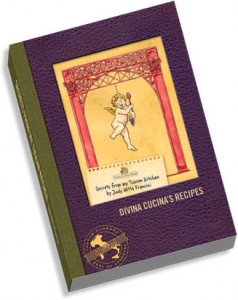 My friend Judy Witts Francini kindly sent me a copy of her handcrafted cookbook, Secrets from My Tuscan Kitchen, and has even more kindly offered to give a lucky Bleeding Espresso reader a chance to win a copy as well.
My friend Judy Witts Francini kindly sent me a copy of her handcrafted cookbook, Secrets from My Tuscan Kitchen, and has even more kindly offered to give a lucky Bleeding Espresso reader a chance to win a copy as well.
To enter the random drawing, all you need to do is comment on this post by 11:59 pm (CET) on Tuesday, March 30, 2010.
Trust me, you’re going to love this cookbook. Not only is it absolutely full of tasty recipes from appetizers to desserts, Judy’s cookbook is also aesthetically pleasing and a cook’s best friend with each page facing the recipes blank so you can add your own notes.
If you don’t know, Italian cooking is very regional, i.e., what you’ll find in Calabria, you probably won’t find in Piemonte, and vice versa. So for those of you who want to get a great taste of what eating in Tuscany is like, you must see Judy’s cookbook, which is based on her own experiences of living in the region for nearly 30 years, particularly as influenced by her Tuscan mother-in-law.
You can read more about Judy’s cookbook and how you can order your own at Judy’s website, Divina Cucina. You can also keep up with Judy at her blog Over a Tuscan Stove and on Twitter @divinacucina.
Of course I wanted to share a recipe with you as I shared Judy’s book this What’s Cooking Wednesday, so I chose something I knew that would be a big hit here. Judy has two recipes for peas in the book, one with pancetta (Piselli alla Fiorentina) and the other with cooked ham (Piselli al Prosciutto); I actually ended up combining the two recipes to adjust for what I had handy (ran out of garlic!), but what I made was closer to Piselli alla Fiorentina, so here you go.
Ah, also, I did leave out the sugar, as P freaks out when he tastes sugar. The peas were definitely sweet enough, and this dish was delicious…and talk about easy peasy! Sorry, couldn’t resist.
Piselli alla Fiorentina
- 1 lb peas
- 2 oz pancetta, cubed
- 1 clove garlic, sliced
- 2 tbs chopped parsley
- 1 tbs sugar
- Salt
- 8 tbs olive oil
1. Place peas, garlic, parsley and olive oil in a saucepan. Add salt to taste.
2. Add enough water to cover peas.
3. Cook over low heat, covered.
4. Just before the peas are done, add the pancetta and sugar. Serve with their sauce.
Buon appetito!
Remember to comment for your chance to a win a copy of Judy’s cookbook!



